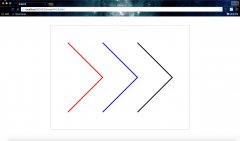Canvas教程(2):基本用法介绍:Canvas教程2基本用法,Canvas教程,基本用法 所属栏目为HTML教程
<canvas>是一个新的HTML元素,这个元素可以被Script语言(通常是JavaScript)用来绘制图形。例如可以用它来画图、合成图象、或做简单的(和不那么简单的)动画。右面的图象展示了一些<canvas>的应用示例,我们将会在此教程中看到他们的实现。
<canvas>最先在苹果公司(Apple)的Mac OS X Dashboard上被引入,而后被应用于Safari。基于Gecko1.8的浏览器,例如Firefox 1.5,也支持这个新元素。元素<canvas>是WhatWG Web applications 1.0也就是大家都知道的HTML 5标准规范的一部分。
在本教程中,我将试着讲述如何在你自己的网页中使用<canvas>元素。提供的示例应该会给你些清晰概念,即用<canvas>能做些什么的。这些示例也可作为你应用<canvas>的起点。
开始使用之前
用元素<canvas>并不难,只要你具有HTML和 JavaScript的基础知识。
如上所述,并不是所有现代浏览器都支持<canvas>元素,所以你需要 Firefox 1.5或更新版本、或者其他基于Gecko的浏览器例如Opera 9、或者最近版本的Safari才能看到所有示例的动作。
<canvas>元素
Let's start this tutorial by looking at the <canvas> element itself.
让我们从<canvas>元素的定义开始吧。
This looks a lot like the <img> element, the only difference is that it doesn't have the src and alt attributes. <canvas>看起来很像<img>,唯一不同就是它不含 src 和 alt 属性。The <canvas> element has only two attributes - width and height. These are both optional and can also be set using DOM properties or CSS rules.它只有两个属性,width 和 height,两个都是可选的,并且都可以 DOM 或者 CSS 来设置。 When no width and height attributes are specified, the canvas will initially be 300 pixels wide and 150 pixels high.如果不指定width 和 height,默认的是宽300像素,高150像素。The element can be sized arbitrarily by CSS, but during rendering the image is scaled to fit its layout size. (If your renderings seem distorted, try specifying your width and height attributes explicitly in the <canvas> attributes, and not with CSS.)虽然可以通过 CSS 来调整canvas的大小,但渲染图像会缩放来适应布局的(如果你发现渲染结果看上去变形了,不必一味依赖CSS,可以尝试显式指定canvas的width 和 height 属性值)。
The id attribute isn't specific to the <canvas> element but is one of default HTML attributes which can be applied to (almost) every HTML element (like class for instance). It's always a good idea to supply an id because this makes it much easier to identify it in our script.
id 属性不是<canvas>专享的,就像标准的HTLM标签一样,任何一个HTML元素都可以指定其 id 值。一般,为元素指定 id 是个不错的主意,这样使得在脚本中应用更加方便。
The <canvas> element can be styled just like any normal image (margin, border, background, etc). These rules however don't affect the actual drawing on the canvas. We'll see how this is done later in this tutorial. When no styling rules are applied to the canvas it will initially be fully transparent. <canvas>元素可以像普通图片一样指定其样式(边距,边框,背景等等)。然而这些样式并不会对canvas实际生成的图像产生什么影响。下面我们会看到如何应用样式。如果不指定样式,canvas默认是全透明的。
替用内容
Because the <canvas> element is still relatively new and isn't implemented in some browsers (such as Firefox 1.0 and Internet Explorer), we need a means of providing fallback content when a browser doesn't support the element.
因为 <canvas> 相对较新,有些浏览器并没实现,如Firefox 1.0 和 Internet Explorer,所以我们需要为那些不支持canvas的浏览器提供替用显示内容。
Luckily this is very straightforward: we just provide alternative content inside the canvas element. Browsers who don't support it will ignore the element completely and render the fallback content, others will just render the canvas normally.
For instance we could provide a text description of the canvas content or provide a static image of the dynamically rendered content. This can look something like this:
我们只需要直接在canvas元素内插入替用内容即可。不支持canvas的浏览器会忽略canvas元素而直接渲染替用内容,而支持的浏览器则会正常地渲染canvas。例如,我们可以把一些文字或图片填入canvas内,作为替用内容:
<canvas id="stockGraph" width="150" height="150"> current stock price: $3.15 +0.15 </canvas> <canvas id="clock" width="150" height="150"> <img src="images/clock.png" width="150" height="150"/> </canvas>结束标签 </canvas> 是必须的
In the Apple Safari implementation, <canvas> is an element implemented in much the same way <img> is; it does not have an end tag. However, for <canvas> to have widespread use on the web, some facility for fallback content must be provided. Therefore, Mozilla's implementation requires an end tag (</canvas>).
在Apple Safari里,<canvas>的实现跟<img>很相似,它并不没有结束标签。然而,为了使 <canvas> 能在web的世界里广泛适用,需要给替用内容提供一个容身之所,因此,在Mozilla的实现里结束标签(</canvas>)是必须的。
If fallback content is not needed, a simple <canvas id="foo" ...></canvas> will be fully compatible with both Safari and Mozilla -- Safari will simply ignore the end tag.
如果没有替用内容,<canvas id="foo" ...></canvas> 对 Safari 和 Mozilla 是完全兼容的—— Safari 会简单地忽略结束标签。
 相关文章
相关文章



 精彩导读
精彩导读
 热门资讯
热门资讯 关注我们
关注我们
